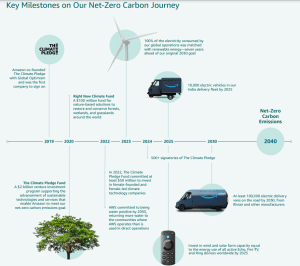Amazon’s latest earnings report reveals a mixed bag: while the retail giant fell short of revenue and advertising expectations, its cloud business, AWS, exceeded forecasts.
As the company navigates these financial setbacks, its commitment to environmental sustainability stands out. Amazon is ramping up its efforts to tackle its carbon footprint and achieve net zero carbon by 2040, even as it grapples with some challenges in its operations.
Earnings Snapshot: AWS Shines Amid Financial Hiccups
Amazon reported Q2 revenue of $148 billion, slightly under the $148.8 billion forecast, with its advertising segment also missing expectations at $12.8 billion versus $13 billion. However, its cloud business, Amazon Web Services (AWS), exceeded expectations with $26.3 billion in revenue.
CFO Brian Olsavsky noted AWS is on track for over $105 billion annually and that Amazon has invested over $30 billion in the first half of the year to support AI and cloud service expansion, with increased investments expected in the second half.
Despite Amazon reporting earnings per share (EPS) of $1.26—beating estimates of $1.04 and nearly doubling profits from the previous year—investors focused on the report’s weaknesses.
Amazon’s stock dropped over 11% in early trading on Friday after its Q3 forecast missed expectations. The company projected sales of $154 billion to $158.5 billion, below the analyst forecast of $158.43 billion. Expected operating income of $11.5 billion to $15 billion fell short of the $15.2 billion anticipated.
Behind the financial misfits lies the retail giant’s success in tackling its environmental and carbon footprint.
Amazon’s Carbon Footprint Progress and Challenges
In 2023, Amazon reduced its absolute carbon emissions by 3%, driven by an 11% decrease in Scope 2 emissions from electricity and a 5% drop in Scope 3 emissions. However, Scope 1 emissions, related to direct operations, increased by 7% due to higher transportation fuel use.
Despite these increases, Amazon’s carbon intensity improved for the fifth consecutive year, dropping 13% from 2022.

Amazon’s Scope 1 emissions, which come from its logistics and transportation fleet, rose by 7% and now represent 21% of its total footprint. This increase is linked to higher package volumes and the growth of Amazon’s logistics network. Efforts to reduce emissions per package include optimizing packaging through AI and reorganizing delivery routes to cut down on travel distances, saving nearly 16 million miles in 2023.
For Scope 2, which covers emissions from electricity used in Amazon’s facilities, there was an 11% decrease, representing 4% of the total footprint. This reduction was achieved by using renewable energy sources, including wind and solar.
In 2023, Amazon matched 100% of its global electricity consumption with renewable energy—seven years ahead of its 2030 target. The company’s renewable energy portfolio expanded to 28 gigawatts, making Amazon the largest corporate buyer of renewable energy for the fourth consecutive year.
Scope 3 emissions, which include those from supply chain activities, decreased by 5% and account for 75% of Amazon’s total carbon footprint. This reduction resulted from improvements in building construction practices and a shift toward using Amazon’s logistics providers.
The online retailer is focusing on reducing embodied carbon in construction by using lower-emission materials, resulting in a decrease of 79,500 metric tons of CO2e from new projects.
Amazon’s Bold Strategy Towards Net Zero
Amazon is committed to achieving net zero carbon emissions by 2040 through a multi-faceted approach involving investment, innovation, and collaboration. The company’s strategy includes reducing its carbon footprint, engaging with suppliers, and investing in carbon-neutralization and carbon-free energy technologies.

At the end of 2023, The Climate Pledge, an initiative Amazon co-founded, included 473 signatories aiming for net zero carbon emissions by 2040. The pledge has seen increased collaboration, with five new joint projects launched in 2023. Amazon supports this effort through its $2 billion Climate Pledge Fund, investing in breakthrough technologies that can lower the cost of decarbonization.
Carbon Neutralization
Amazon’s priority is to eliminate emissions within its operations and invest in carbon-neutralization efforts. This includes reducing emissions through targeted investments and partnerships, focusing on three key areas:
- reducing deforestation,
- advancing nature-based carbon removal, and
- scaling up carbon removal technologies.
The company engages in initiatives such as the Lowering Emissions by Accelerating Forest Finance (LEAF) Coalition, which mobilizes funds to protect tropical forests and support community programs. Amazon also funds projects like SeloVerde, an AI tool for deforestation traceability, and supports agroforestry projects in the Amazon rainforest to enhance carbon storage and community livelihoods.
Carbon-Free Energy
Amazon’s net zero strategy includes transitioning to carbon-free energy sources, such as wind, solar, and nuclear power. The company has set ambitious goals to match 100% of its electricity consumption with renewable energy and invest in wind and solar capacity equivalent to the energy used by its Echo, Fire TV, and Ring devices.
Amazon’s efforts extend to energy efficiency, with innovations aimed at optimizing operational energy use and reducing energy consumption. The company is also expanding battery storage to support grid decarbonization and exploring diverse carbon-free energy sources to ensure a resilient and sustainable energy supply.

Supplier Engagement and Technology Investment
A significant part of Amazon’s strategy involves working with suppliers to reduce emissions across the supply chain. The retail and cloud giant has identified its highest-emitting suppliers, representing over 50% of its Scope 3 emissions, and expects them to provide decarbonization plans.
The company has launched the “Amazon Sustainability Exchange,” a platform to share resources and guidelines to help other companies achieve net zero carbon emissions. This engagement is crucial as Scope 3 emissions are beyond Amazon’s direct control but play a significant role in the overall carbon footprint – over 50% of Scope 3 emissions.
Amazon continues to invest in emerging technologies to advance its sustainability goals. This includes supporting direct air capture (DAC) technologies that remove CO2 from the atmosphere and investing in modular DAC systems to drive down costs and scale up carbon removal efforts.
Overall, behind financial hiccups, Amazon continues to invest in carbon abatement projects and innovative technologies, such as electric vehicles and energy-efficient chips, to drive long-term decarbonization and enhance sustainability across its operations.

